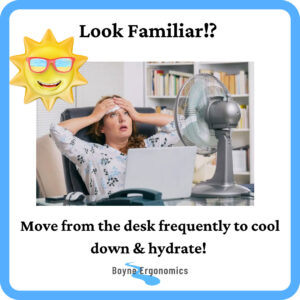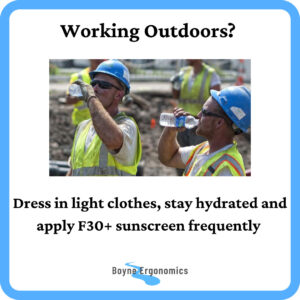The heatwave has arrived here in Ireland and whether you are a sun worshiper or a sun dodger (like me!), it is so important that you know how to manage heat in the workplace. This is to help you not only remain comfortable and able to function to the best of your ability, but also to help avoid the risk of heat-related and sun exposure related illness.
Why Is Excessive Heat & Sun Exposure A Risk Factor?
As individual experiences of temperature can vary, the management of heat in the workplace is based around the term Thermal Comfort. This refers to how comfortable and acceptable the temperature is in the workplace and is determined by both environmental factors, such as temperature and humidity levels, and individual factors, such as clothing worn and physical exertion associated with the tasks.
According to HSENI, employees that are exposed to extreme heat can suffer symptoms that include discomfort, dehydration and exhaustion.
We all know that sticky tiredness that we can experience at the workstation when it feels too hot and humid. It is uncomfortable and can make it difficult to concentrate and stay motivated. These symptoms can reduce productivity and increase absenteeism. This is the low end of the risk scale.
Prolonged exposure to heat or exposure to excessive heat can cause illness or even death. The illnesses that can be caused by heat exposure include heat rashes, heat cramps, heat exhaustion and heat stroke.

When working outdoors, we are not just concerned with heat exposure, but also with sun exposure.
As per HSA, the annual rates of both melanoma and non-melanoma skin cancers (NMSC) are increasing steadily in Ireland. There are over 1000 cases of melanoma and almost 12,000 cases of non-melanoma annually.
The main cause of skin cancer is ultraviolet (UV) light from the sun. Sun exposure is the best natural source of Vitamin D and is important for good general health. We can all enjoy the outdoors but we just need to think about how we protect our skin when outside. Outdoor workers are at higher risk than other workers.
What Employees Can Do To Keep Cool When Working Indoors
Wear light clothing
Open windows
Pull blinds / curtains when sun is shining directly in
Stay hydrated with plenty of water
Use a fan to create air flow
Take frequent breaks from the desk to move around, get a glass of water and some fresh air!
Take phone calls on the move, outdoors in the shade if possible

What Employees Can Do To Keep Cool & Reduce UV Exposure When Working Outdoors
Drink cool water, even if you are not thirsty
Wear a high factor sunscreen and reapply frequently
Avoid outdoor work between 11am-3pm if possible. If this is not possible, try and work in shaded areas during these hours
Take regular rest breaks in cool or shaded areas
Wear a hat with a brim
Dress for the heat, aim for light cotton-based clothing if possible

What Employers Can Do To Help Reduce Risk & Employee Discomfort
For employees based indoors:
Adjust air conditioning units, or install them if not already available
Open more windows to improve air flow and ventilation
Provide employees with fans
Install adjustable blinds on the windows
Provide cold drinking water
Insulate hot pipework
Move workstations away from direct sunlight and other sources of heat
Job / task rotation
Relax rules on wearing uniforms
For employees based outdoors:
Employers need to make sure that their workers can keep hydrated easily and can protect their skin from UV radiation damage.
If possible, plan outdoor work in sunny weather to limit duration and intensity of employee exposure to direct sunlight (11am to 3pm sun rays are most intense)
If workers are not acclimatised, or not used to working in high heat levels, ensure a gradual exposure to working in the heat. On the first day, employees should work no more than 20% of their shift at full intensity in the heat. This should increase by no more than 20% a day to allow the body to adapt.
Limit duration of exposure if possible when UV index is high (3 or above), do indoor work if possible
Provide shade if possible, or if that is not possible, there should be shade for breaks
Give information to employees about dangers of sun exposure
Ensure workers have easy access to safe drinking water. Workers should have enough time to hydrate – as the outdoor temperature rises the frequency of water breaks should go up
Inform employees about the Sun Smart code
Educate and encourage employees to self-check skin for signs of skin cancer
Check UV index, if 3 or above greater risk www.met.ie/uv-index
Ensure breaks are taken out of direct sunlight
Encourage employees to cover up, keep clothing on with sleeves down, collars up and wear clothing with high ultraviolet protection factor (UPF), 15 or more, wear wide-brimmed hat
Ensure employees do not strip off clothing when it is sunny
Provide sunscreen, SPF of at least 30+ with a high UVA protection and water resistance. Reapply regularly.
Provide sunglasses, wraparound are best.
Sources
https://www.hseni.gov.uk/articles/temperatures-workplace
https://www.hsa.ie/eng/topics/sun_protection/
https://www.osha.gov/sites/default/files/publications/OSHA3975.pdf
https://www.osha.gov/sites/default/files/publications/osha3154.pdf


